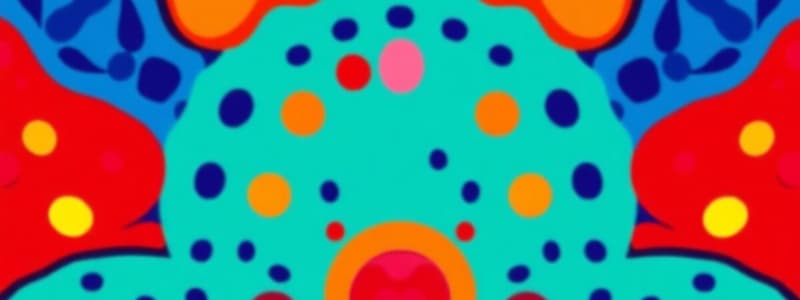Podcast
Questions and Answers
Which type of DNA is found in smaller organisms that appeared approximately 4 billion years ago?
Which type of DNA is found in smaller organisms that appeared approximately 4 billion years ago?
- Nuclear DNA
- Hybrid DNA
- Linear DNA
- Circular DNA (correct)
What is one of the functions of tissues mentioned in the content?
What is one of the functions of tissues mentioned in the content?
- Photosynthesis
- Respiration
- Protection (correct)
- Translation of Genetic Material
Which type of epithelial tissue is described as having a single layer but appears thicker due to the differing heights of its nuclei?
Which type of epithelial tissue is described as having a single layer but appears thicker due to the differing heights of its nuclei?
- Pseudostratified Epithelium (correct)
- Simple Squamous Epithelium
- Cuboidal Epithelium
- Stratified Columnar Epithelium
What component is described as a macromolecule in the extracellular matrix?
What component is described as a macromolecule in the extracellular matrix?
Which of the following statements incorrectly describes cells that are generally larger in size?
Which of the following statements incorrectly describes cells that are generally larger in size?
In terms of tissue properties, what does the term 'apical' refer to?
In terms of tissue properties, what does the term 'apical' refer to?
Which statement is true about the similarities between larger and smaller organisms?
Which statement is true about the similarities between larger and smaller organisms?
What term describes the study of human and animal tissues?
What term describes the study of human and animal tissues?
What is the primary role of skeletal muscle tissue?
What is the primary role of skeletal muscle tissue?
What characteristic distinguishes cardiac muscle tissue from skeletal muscle tissue?
What characteristic distinguishes cardiac muscle tissue from skeletal muscle tissue?
Which part of muscle fibers is responsible for enclosing them?
Which part of muscle fibers is responsible for enclosing them?
Which of the following accurately describes the control of skeletal muscle movements?
Which of the following accurately describes the control of skeletal muscle movements?
During the pumping of blood, which chamber of the heart receives deoxygenated blood?
During the pumping of blood, which chamber of the heart receives deoxygenated blood?
What unique feature can be observed in the appearance of skeletal muscle tissue?
What unique feature can be observed in the appearance of skeletal muscle tissue?
Which of the following best describes the function of cardiac muscle tissue?
Which of the following best describes the function of cardiac muscle tissue?
What is the primary component of muscle fibers that aids in contraction?
What is the primary component of muscle fibers that aids in contraction?
Which statement accurately describes smooth muscle tissue?
Which statement accurately describes smooth muscle tissue?
What is the primary function of neuroglia?
What is the primary function of neuroglia?
What distinguishes neurons from neurosecretory cells?
What distinguishes neurons from neurosecretory cells?
Which of the following parts of a neuron is responsible for receiving signals?
Which of the following parts of a neuron is responsible for receiving signals?
What role does the axon hillock play in neuronal function?
What role does the axon hillock play in neuronal function?
Which of the following correctly describes the Central Nervous System (CNS)?
Which of the following correctly describes the Central Nervous System (CNS)?
What defines the lateral plant tissue system?
What defines the lateral plant tissue system?
Which characteristic is NOT typical of smooth muscle fibers?
Which characteristic is NOT typical of smooth muscle fibers?
What is the primary function of mitochondria in a cell?
What is the primary function of mitochondria in a cell?
Which organelle is responsible for finishing, sorting, and shipping proteins within a cell?
Which organelle is responsible for finishing, sorting, and shipping proteins within a cell?
What type of endoplasmic reticulum is involved in synthesizing and processing proteins?
What type of endoplasmic reticulum is involved in synthesizing and processing proteins?
Which cellular component is solely responsible for helping coordinate cell division?
Which cellular component is solely responsible for helping coordinate cell division?
What is the role of ribosomes in the cell?
What is the role of ribosomes in the cell?
What do chloroplasts primarily accomplish in plant cells?
What do chloroplasts primarily accomplish in plant cells?
Which structure protects the DNA within the cell?
Which structure protects the DNA within the cell?
What type of energy is ATP considered in a biological context?
What type of energy is ATP considered in a biological context?
How do cells make sure to replicate properly before division?
How do cells make sure to replicate properly before division?
What is one function of the smooth endoplasmic reticulum?
What is one function of the smooth endoplasmic reticulum?
What is the main purpose of the M phase in the cell cycle?
What is the main purpose of the M phase in the cell cycle?
During which phase do chromosomes coil up and the nuclear envelope disappears?
During which phase do chromosomes coil up and the nuclear envelope disappears?
What holds sister chromatids together during cell division?
What holds sister chromatids together during cell division?
What type of DNA is present in a nondividing cell?
What type of DNA is present in a nondividing cell?
Which phase involves chromosomes lining up in the middle of the cell?
Which phase involves chromosomes lining up in the middle of the cell?
What is the role of inspection points in the cell cycle?
What is the role of inspection points in the cell cycle?
What occurs during Anaphase of mitosis?
What occurs during Anaphase of mitosis?
Which description fits the term 'chromosome' during the cell cycle?
Which description fits the term 'chromosome' during the cell cycle?
Flashcards are hidden until you start studying
Study Notes
DNA Types
- Circular DNA is typically smaller and appeared 4 billion years ago.
- Linear DNA is larger and evolved around 1 billion years ago.
- Both types contain DNA, ribosomes, plasma membrane, cytoplasm, and cytoskeleton.
Tissue Overview
- Composed of similar cells and their extracellular matrix, performing a specific function.
- Histology studies tissues in humans and animals.
- Extracellular matrix consists of macromolecules like carbohydrates and amino acids.
Functions of Tissues
- Protection
- Connection
- Movement and locomotion
- Transmission of signals
Types of Epithelial Tissue
- Pseudostratified Epithelium has irregular nuclei but only one layer.
- Transitional Epithelium features rounded cells.
- Squamous Epithelium consists of flat, thin, scale-like cells and lines blood vessels and the heart.
Organelles
Mitochondria
- Responsible for ATP production via cellular respiration (sugar + O2 → ATP).
- Features a double membrane.
Chloroplasts
- Perform photosynthesis (sunlight + CO2 → ATP & sugar).
- Convert energy to sugar, vital for plant growth.
Ribosomes
- Act as protein factories, synthesizing proteins from DNA instructions.
- Can be free in cytoplasm or attached to Endoplasmic Reticulum (ER).
Endoplasmic Reticulum
- Rough ER has ribosomes and assists in protein synthesis.
- Smooth ER produces membranes and fatty acids.
Golgi Apparatus
- Finishes, sorts, labels, and ships proteins in vesicles, likened to a shipping center.
Centrioles
- Assist in coordinating cell division and are present only in animal cells.
Muscle Tissue
- Skeletal muscle: Striated, conscious control; consists of fibers.
- Cardiac muscle: Striated and branched, pumps blood throughout the body.
- Smooth muscle: Non-striated, helps move food along the gastrointestinal tract.
Nervous Tissue
- Comprises the Central Nervous System (brain and spinal cord) and Peripheral Nervous System (peripheral nerves).
- Neurons transmit electrochemical signals and have specialized structures (cell body, dendrites, axon).
Plant Tissues
- Grouped into systems performing specialized functions; essential for plant organ connectivity.
Cell Cycle
- Involves growth and division, regulated by DNA within the nucleus.
- Chromatin refers to non-dividing, thread-like DNA; chromosomes are coiled and short in dividing cells.
Mitosis Overview
- Prophase: Chromosomes coil, nuclear envelope disappears, spindle fibers form.
- Metaphase: Chromosomes align centrally, spindle fibers attach.
- Anaphase: Chromosome copies separate to opposite sides of the cell.
Application of Cell Cycle
- New skin cells form at the epidermis' deepest layer and migrate to the surface.
- Checkpoints ensure size and nutrient sufficiency before progressing to the next cell cycle stage.
Studying That Suits You
Use AI to generate personalized quizzes and flashcards to suit your learning preferences.




